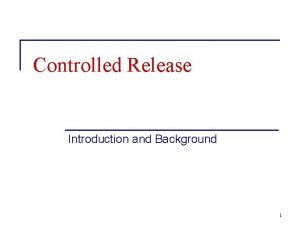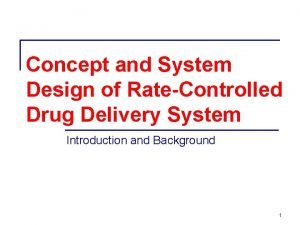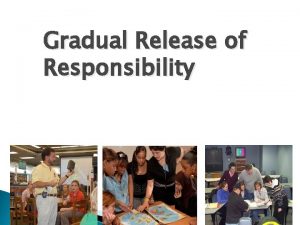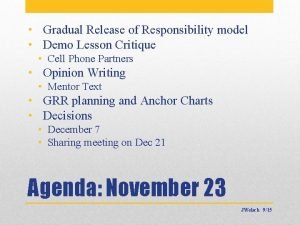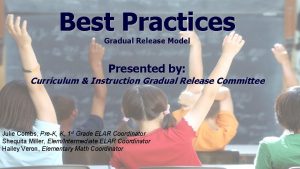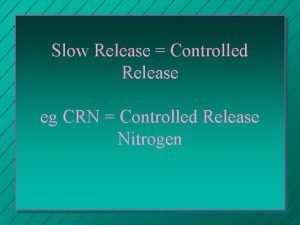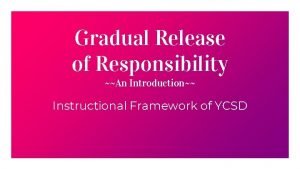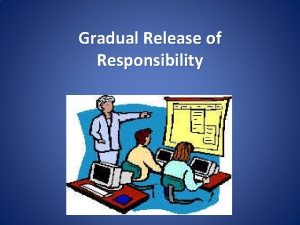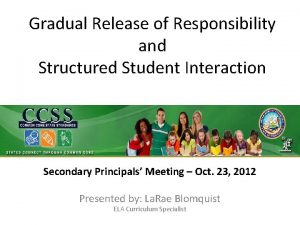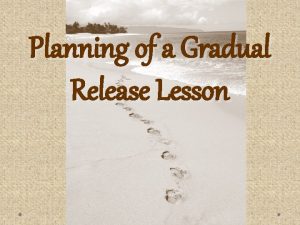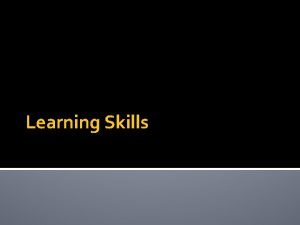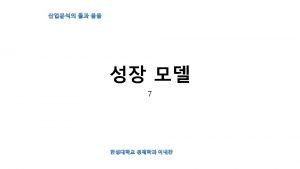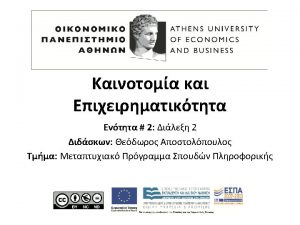The Gradual Release Model for Learning GRADUAL RELEASE


















- Slides: 18

The “Gradual Release Model for Learning

“GRADUAL RELEASE MODEL” INVOLVES. . • I do • We do • You do

THE LEARNING CYCLE—A MODEL FOR LEARNING

LEARNING MATH • Studies have shown that math learners may fail 4 to 5 times before mastering a new concept. • To minimize the frustration that can occur during this process, the “Gradual Release Template” is used.

DAY ONE—I DO • On day one of a new concept, I will teach the process and work example problems to help the learner understand the new material.

DAY TWO—”WE DO” • On day two, the students and teacher will interactively work example problems. • A problem will be displayed and all will be asked to attempt to solve it. • A student will be selected at random to explain the solution. • If a student does not know how to solve the problem, assistance will be given

DAY TWO—”WE DO” • All students are expected to participate. • Student participation amounts to 20% of the assignments score!

DAY-THREE—”YOU DO” AKA INDEPENDENT PRACTICE • By this time, students have seen (if they were focused) and worked numerous examples. • A work assignment (typically around 10 -20 problems total. As many as half are lookup’s and require no calculation) is given and is due at the end of class. • A student is still allowed to ask the teacher for assistance; however, at this point, I will only remove the immediate obstacle. The student will still be expected to solve the rest of the problem

WHERE TO GO FOR HELP • The work sheets contain example problems that are the same format as the assignment problems. The student just has to substitute their new numbers into the original example. • Students are encouraged to use Math. Nation videos and on-line help. • There are office texts students may use as an additional resource. • A student is encouraged to come by during office-hours for assistance. • The slide-shows are posted on my webpage.

PHASE 3—”YOU DO” Sometimes this transition my appear too abrupt.

The sudden release of responsibility TEACHER RESPONSIBILITY “I do it” Focus Lesson Independent “You do it alone” STUDENT RESPONSIBILITY Fisher, D. , & Frey, N. (2008). Better learning through structured teaching: A framework for the gradual release of responsibility. Alexandria, VA: Association for Supervision and Curriculum Development.

EASING THE TRANSITION “Circuit breakers” help ease the transition. Collaborative work with a shoulder partner is allowed. I am available to remove the immediate roadblock. Usually this involves some inquiry to determine where the student is failing to grasp the process.

TEACHER RESPONSIBILITY “I do it” Focus Lesson Guided Instruction “We do it” Collaborative “You do it together” Independent “You do it alone” STUDENT RESPONSIBILITY A Model for Success for All Students Fisher, D. , & Frey, N. (2008). Better learning through structured teaching: A framework for the gradual release of responsibility. Alexandria, VA: Association for Supervision and Curriculum Development.

FILLING IN THE GAPS If there is a “gap” in the students knowledge, he or she may be asked to review certain material before proceeding any further with the problem.

DAY-THREE (YOU CAN DO IT!) • Students who have been focused during the cycle usually complete their work with time to spare. An “enrichment” assignment is available if needed.

WHERE NOT TO GO • This is a student’s individual work. They are not allowed to copy answers for either another student or the internet. • A student is expected to show appropriate work to support their solution on problems that require calculation. If in doubt, work it out! • Failure to comply may result in partial or complete loss of the students score for that assignment!

UNEXCUSED ABSENCE, LATE WORK AND PAST-DUE WORK • The (“ 59”) rule(s) pertaining to excused/ unexcused absences will apply to all work that is not late-work. You must have a note of missed assignment days or you will receive a “ 59”. • Work is due at the end of class. • At one-day least 1 homework night and class day grace period allowed before late penalties are assessed.

PAST-DUE WORK • Past due work is assessed a 30% penalty if submitted before the next quiz. • Past due work is assessed a 40% penalty if submitted after the quiz. • Please remain focused so you can receive full credit for your work!
 Gradual release of responsibility pedagogy
Gradual release of responsibility pedagogy Sustained release
Sustained release Ocusert definition
Ocusert definition Extended release vs sustained release
Extended release vs sustained release Cuadro comparativo e-learning m-learning b-learning
Cuadro comparativo e-learning m-learning b-learning Pac learning model in machine learning
Pac learning model in machine learning Machine learning t mitchell
Machine learning t mitchell Fspos vägledning för kontinuitetshantering
Fspos vägledning för kontinuitetshantering Novell typiska drag
Novell typiska drag Nationell inriktning för artificiell intelligens
Nationell inriktning för artificiell intelligens Ekologiskt fotavtryck
Ekologiskt fotavtryck Varför kallas perioden 1918-1939 för mellankrigstiden
Varför kallas perioden 1918-1939 för mellankrigstiden En lathund för arbete med kontinuitetshantering
En lathund för arbete med kontinuitetshantering Adressändring ideell förening
Adressändring ideell förening Tidbok yrkesförare
Tidbok yrkesförare Sura för anatom
Sura för anatom Densitet vatten
Densitet vatten Datorkunskap för nybörjare
Datorkunskap för nybörjare Tack för att ni lyssnade bild
Tack för att ni lyssnade bild


